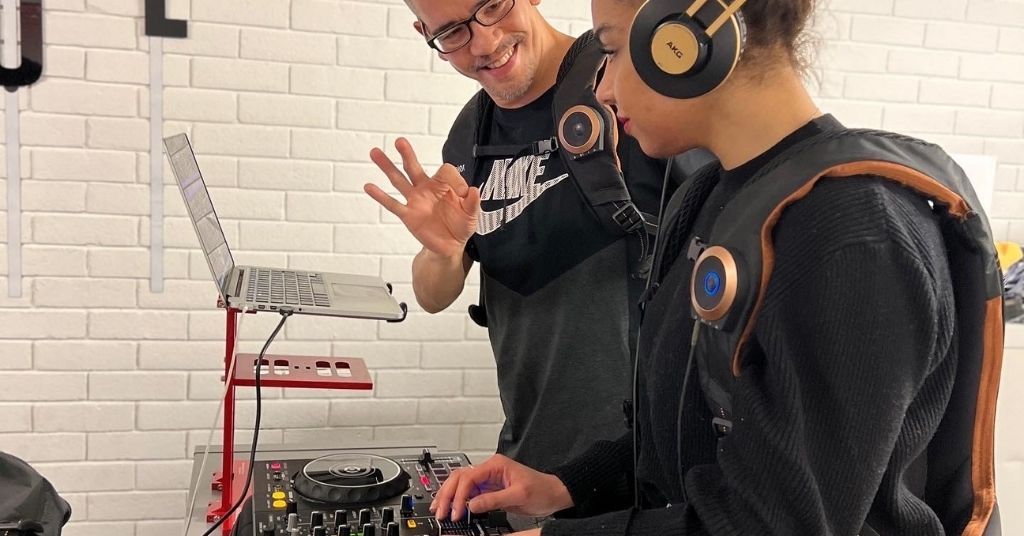
Learning Sign Language with a Baby or Toddler
January 12, 2016
Parents push the boundaries for deaf kids
January 15, 2016Making Music Again – A Grand Leap Forward with Hearing Loss

I recently wrote about performing music again long after I had assumed that those days were over. But I was convinced to try again after learning about new hearing aid technology (my Phonak Audéo V), research about the brain, hearing rehab, vocal training and dedication for lots of practice.
When I first started preforming again I chose familiar venues – a friend’s home and a local establishment – and then enlisted my own audiences through an e-mail newsletter, social media postings, and personal referrals, not knowing what might come from my performance. Each concert was full – about 30 people – and the response was warm and positive.
The first two performances were less than precise and the feedback that I received, albeit encouraging, indicated that more work was needed.
At first blush, it appeared that I did not account for other variables that might have improved my performance and more closely met my standards. After the second performance, in fact, I considered ending the test runs until I could be more “sure.”
But when is that exactly? And sure of what? I didn’t know.
As the fates saw to it, an angel was in the audience at my second concert: my friend Steve. We have been friends for many years and he’s been a longstanding fan of my music. He is also a singer of light opera and show tunes with the necessary background in rock and roll as a musician, singer, techie and roadie. And he has perfect pitch.
After the first set he took me aside to tell me to slow down, to use my pitch guides (harmonicas and a pitch pipe) and that it seemed to him that I was on top of the notes I was singing, i.e.: I was singing sharp. Interestingly, he said that when I sang cover tunes of other artists, I was right on pitch. I was sharp only when I sang my own songs. Perhaps, we wondered, my muscle memory is stronger for songs that I sang for decades than my own more recent compositions.
As the second half of my concert began, I admitted to my audience that if they had not already surmised, I was having trouble with pitch in certain instances. I declared the show from that moment on a “work in progress” and asked for their patience and support as I worked through the issues. It seemed to relax us all. I now promote my current concerts as “works in progress” to keep expectations in a healthy place.
After the November concert, Steve offered to help me work the sound for my performances to find the right balance between piano, voice and room acoustics. Until then, I had resisted using a microphone and amplifier that I did not yet feel ready to employ. But now Steve and I agreed to test them to at very least lessen the pressure on me to have to over-project my voice – a possible reason that I was pushing sharp on my vocals. The test worked well and we agreed to use them at my next concert.
My audiologist and I discussed the various program settings on my hearing aid and how I might adjust them to assist me better in performance. My hearing rehab mentor, Geoff, had me play a small digital piano and sing for him. He said I was doing well pitch-wise, and interestingly, suggested that as part of my rehearsals I might recite the songs rather than sing them, and that if the moment was right, to do the same in a concert performance.
My audiologist and I discussed the various program settings on my hearing aid and how I might adjust them to assist me better in performance.
My voice teacher also declared my pitch to be good as I sat at the piano and sang for her. She identified for me, however, that singing and playing simultaneously was sensory overload and suggested that I work with a piano player so that I could focus my attentions on singing. She stressed correct breathing as the necessity it is to both find and sustain pitch. She also cleverly suggested that I play the first notes of any melody along with my vocal to set me off on key. I could also revisit the melody with my right hand during the song as a continuing guide.
Nancy also told me to reach for the notes that I sang and be more conscious of listening to them and finding them. I notice with my hearing aid in different settings that sometimes, if I am not really listening, I can get a “false “positive” and think that I am singing the right note but still be above it (sharp).
Feeling confident again that I had reached another stage in my “comeback.” I decided to plan another “work in progress” performance and chose a venue with lifelong resonance for me – the Lion’s Den at the Red Lion Inn in Stockbridge, Massachusetts. Between 1971-1973 I had performed every Friday and Saturday night in this historic New England Inn – a place that remains magnetic north in my musical soul.
It was here where I became a singer-songwriter in an era when singer-songwriters ruled the music world. I enjoyed a loyal following and in 1973 I recorded a demo of some of my songs at a small studio nearby that led to my first recording contract. After I had lost my hearing I vowed that if I had one wish left it would be to perform at the Lion’s Den again. So, I set it up to make sure that I did.
After I had lost my hearing I vowed that if I had one wish left it would be to perform at the Lion’s Den again. So, I set it up to make sure that I did.
Nervous, yes, but this was ‘coming home,’ and I had taken several steps forward before arriving December 12 for my concert. When Steve and I arrived, we saw that the Den’s sound system was compatible with our needs. It also had a small monitoring system on the ceiling pointed back at the stage that gave me a perfect kick back of my piano and voice. With a few tweaks, we had the next generation of sound we had been looking for.
The evening went considerably better than the previous concerts, though I chose to perform only my own music and not include any cover songs. I also made sure to promote this “work in progress” for weeks ahead of time. That night I also suggested to my audience that they consider anything and everything that occurred during my performance to be, simply, “part of the act.” An appreciative and supportive chuckle filled the room.
It helped, too, that the Den was filled with friends of every stripe – grammar school classmates, locals who had seen me perform years ago as well as current close friends and intimates.
The first set went well. My pitch was good and the songs were well received. The second set started off well but as the Lion’s Den began to fill up with folks who had moved in from the street, enjoying the unseasonal weather and the holiday spirit, the noise level picked up considerably. I kept my focus but the noise caused enough aural confusion that Steve confirmed that I was going sharp again.
One moment I was having so much fun that I thought I could return to the Red Lion again, possibly regularly. The next moment the noise reminded me of that time 40 years ago when the Den was filled with loud crowds and cigarette smoke. I had no idea how I had survived back then but I was not about to put myself in the middle of that again. ‘Tonight’ would have to do.
Nevertheless, from every perspective the performance was a positive and had given me more vital information for my work ahead. I had decided to close my concert with a song I wrote and recorded with Epic Records in 1976 called “I’ve Got Music.” The song nicely sums up the musical spirit and vision that were launched in the Lion’s Den all those years ago. I took Geoff’s advice and recited it rather than sing it – just to be sure there was no confusion about what music means to me.
I’ve got music
I’ve got something to live for
I’ve got music
I’ve got something to live for
Something to love, something to give
I’ve got music
Running through my veins
I’ve got rainbows
Every time it rains
And I’ve got you
To get me through tomorrow
I’ve got dreams, I’ve still got dreams. (c. 1973 Busker Music)
I have decided to take the next step and begin recording demos of my new compositions. I feel ready vocally, have a sizable backlog of songs, and will have an extra layer of control that live performing does not provide. I will continue “works in progress” as opportunities avail themselves. And I will report back on my progress.
If you are a musician with a hearing loss and are looking to perform again, I encourage you to let ‘er rip. Work through your own process and get yourself “lined up” and comfortable with your tech as best you can. Fall down and get back up. As the old saying goes, be sharp, be flat but always be natural. There really is no other way. If you love performing as much as I do, you can do it – whatever it takes.
Whatever it takes.
Stu Nunnery is a writer, composer, singer, musician, recording artist, actor and activist from Rhode Island. He has a special kinship and interest in musicians and singers with hearing loss, but writes on a variety of hearing issues from his 34 years experience with bilateral sensorineural hearing loss. He has hearing in one ear and sight in one eye, which makes for interesting sensory challenges from time to time.
You can follow him here on Open Ears on a regular basis, or on Twitter @stununnery, where he hopes he will be of help, hope and inspiration to those of whom he affectionately calls the “hearing lost.”








